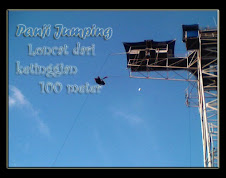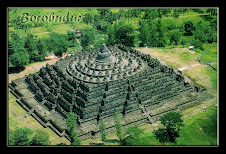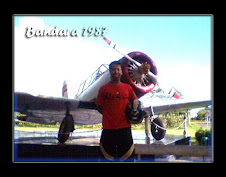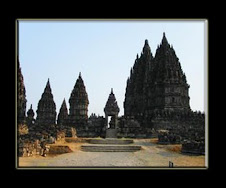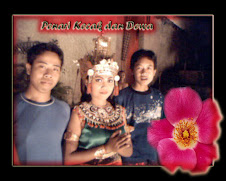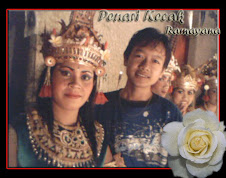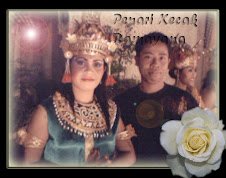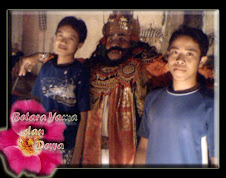 StudyTour ke Jawa memang memory yang sangat mengesankan karena bersama-sama seluruh temen-temen SMEA tanpa terkecuali, karena diwajibkan lho oleh sekolah. Disamping mengunjugi Candi Borobudur yaitu candi terbesar di Indonesia kami juga mengunjungi Candi Perambanan yang merupakan Cand tertinggi di Indonesia.
StudyTour ke Jawa memang memory yang sangat mengesankan karena bersama-sama seluruh temen-temen SMEA tanpa terkecuali, karena diwajibkan lho oleh sekolah. Disamping mengunjugi Candi Borobudur yaitu candi terbesar di Indonesia kami juga mengunjungi Candi Perambanan yang merupakan Cand tertinggi di Indonesia.Di sini suasananya lebih sejuk dari candi Borobudur karena candi yang tinggi akan memberikan kita tempat untuk berteduh dari teriknya matahari. Perlu juga diingat kalau tamasya ke tempat-tempat seperti ini saya saranin agar membawa uang recehan karena baru aja bisnya parker langsung diserbu para pengamen.
Disepanjang jalan keluar Candi kita akan banyak menemui artshop-artshop yang menjual berbagai barang kerajinan Jogja tentunya yang paling banyak dijual yaitu yang berbau candi Perambanan seperti Patung candi Perambanan, lukisan candi Ini, dan lain sebagainya. Satu lagi harga pakaian disini relative lebih murah daripada di Bali, karena pabriknya disana mungkin ya,..?
Candi Prambanan adalah bangunan luar biasa cantik yang dibangun di abad ke-10 pada masa pemerintahan dua raja, Rakai Pikatan dan Rakai Balitung. Menjulang setinggi 47 meter (5 meter lebih tinggi dari Candi Borobudur), berdirinya candi ini telah memenuhi keinginan pembuatnya, menunjukkan kejayaan Hindu di tanah Jawa. Candi ini terletak 17 kilometer dari pusat kota Yogyakarta, di tengah area yang kini dibangun taman indah.
Ada sebuah legenda yang selalu diceritakan masyarakat Jawa tentang candi ini. Alkisah, lelaki bernama Bandung Bondowoso mencintai Roro Jonggrang. Karena tak mencintai, Jonggrang meminta Bondowoso membuat candi dengan 1000 arca dalam semalam. Permintaan itu hampir terpenuhi sebelum Jonggrang meminta warga desa menumbuk padi dan membuat api besar agar terbentuk suasana seperti pagi hari. Bondowoso yang baru dapat membuat 999 arca kemudian mengutuk Jonggrang menjadi arca yang ke-1000 karena merasa dicurangi.
Candi Prambanan memiliki 3 candi utama di halaman utama, yaitu Candi Wisnu, Brahma, dan Siwa. Ketiga candi tersebut adalah lambang Trimurti dalam kepercayaan Hindu. Ketiga candi itu menghadap ke timur. Setiap candi utama memiliki satu candi pendamping yang menghadap ke barat, yaitu Nandini untuk Siwa, Angsa untuk Brahma, dan Garuda untuk Wisnu. Selain itu, masih terdapat 2 candi apit, 4 candi kelir, dan 4 candi sudut. Sementara, halaman kedua memiliki 224 candi.
Memasuki candi Siwa yang terletak di tengah dan bangunannya paling tinggi, anda akan menemui 4 buah ruangan. Satu ruangan utama berisi arca Siwa, sementara 3 ruangan yang lain masing-masing berisi arca Durga (istri Siwa), Agastya (guru Siwa), dan Ganesha (putra Siwa). Arca Durga itulah yang disebut-sebut sebagai arca Roro Jonggrang dalam legenda yang diceritakan di atas.
Di Candi Wisnu yang terletak di sebelah utara candi Siwa, anda hanya akan menjumpai satu ruangan yang berisi arca Wisnu. Demikian juga Candi Brahma yang terletak di sebelah selatan Candi Siwa, anda juga hanya akan menemukan satu ruangan berisi arca Brahma.
Candi pendamping yang cukup memikat adalah Candi Garuda yang terletak di dekat Candi Wisnu. Candi ini menyimpan kisah tentang sosok manusia setengah burung yang bernama Garuda. Garuda merupakan burung mistik dalam mitologi Hindu yang bertubuh emas, berwajah putih, bersayap merah, berparuh dan bersayap mirip elang. Diperkirakan, sosok itu adalah adaptasi Hindu atas sosok Bennu (berarti 'terbit' atau 'bersinar', biasa diasosiasikan dengan Dewa Re) dalam mitologi Mesir Kuno atau Phoenix dalam mitologi Yunani Kuno. Garuda bisa menyelamatkan ibunya dari kutukan Aruna (kakak Garuda yang terlahir cacat) dengan mencuri Tirta Amerta (air suci para dewa).
Kemampuan menyelamatkan itu yang dikagumi oleh banyak orang sampai sekarang dan digunakan untuk berbagai kepentingan. Indonesia menggunakannya untuk lambang negara. Konon, pencipta lambang Garuda Pancasila mencari inspirasi di candi ini. Negara lain yang juga menggunakannya untuk lambang negara adalah Thailand, dengan alasan sama tapi adaptasi bentuk dan kenampakan yang berbeda. Di Thailand, Garuda dikenal dengan istilah Krut atau Pha Krut.
Prambanan juga memiliki relief candi yang memuat kisah Ramayana. Menurut para ahli, relief itu mirip dengan cerita Ramayana yang diturunkan lewat tradisi lisan. Relief lain yang menarik adalah pohon Kalpataru yang dalam agama Hindu dianggap sebagai pohon kehidupan, kelestarian dan keserasian lingkungan. Di Prambanan, relief pohon Kalpataru digambarkan tengah mengapit singa. Keberadaan pohon ini membuat para ahli menganggap bahwa masyarakat abad ke-9 memiliki kearifan dalam mengelola lingkungannya.
Sama seperti sosok Garuda, Kalpataru kini juga digunakan untuk berbagai kepentingan. Di Indonesia, Kalpataru menjadi lambang Wahana Lingkungan Hidup (Walhi). Bahkan, beberapa ilmuwan di Bali mengembangkan konsep Tri Hita Karana untuk pelestarian lingkungan dengan melihat relief Kalpataru di candi ini. Pohon kehidupan itu juga dapat ditemukan pada gunungan yang digunakan untuk membuka kesenian wayang. Sebuah bukti bahwa relief yang ada di Prambanan telah mendunia.
Kalau cermat, anda juga bisa melihat berbagai relief burung, kali ini burung yang nyata. Relief-relief burung di Candi Prambanan begitu natural sehingga para biolog bahkan dapat mengidentifikasinya sampai tingkat genus. Salah satunya relief Kakatua Jambul Kuning (Cacatua sulphurea) yang mengundang pertanyaan. Sebabnya, burung itu sebenarnya hanya terdapat di Pulau Masakambing, sebuah pulau di tengah Laut Jawa. Lalu, apakah jenis itu dulu pernah banyak terdapat di Yogyakarta? Jawabannya silakan cari tahu sendiri. Sebab, hingga kini belum ada satu orang pun yang bisa memecahkan misteri itu.
Nah, masih banyak lagi yang bisa digali di Prambanan. Anda tak boleh jemu tentunya. Kalau pun akhirnya lelah, anda bisa beristirahat di taman sekitar candi. Tertarik? Datanglah segera. Sejak tanggal 18 September 2006, anda sudah bisa memasuki zona 1 Candi Prambanan meski belum bisa masuk ke dalam candi. Beberapa kerusakan akibat gempa 27 Mei 2006 lalu kini sedang diperbaiki.
Prambanan adalah kompleks candi Hindu terbesar di Indonesia, dan terletak di pulau Jawa, kurang lebih 20 km timur Yogyakarta, 40 km barat Surakarta dan 120 km selatan Semarang, persis di perbatasan antara provinsi Jawa Tengah dan Daerah Istimewa Yogyakarta. Candi Prambanan terletak di desa Prambanan yang wilayahnya dibagi antara kabupaten Sleman dan Klaten. Candi ini dibangun pada sekitar tahun 850 Masehi oleh salah seorang dari kedua orang ini, yakni: Rakai Pikatan, raja kedua wangsa Mataram I atau Balitung Maha Sambu, semasa wangsa Sanjaya. Tidak lama setelah dibangun, candi ini ditinggalkan dan mulai rusak. Renovasi candi ini dimulai pada tahun 1918, dan sampai sekarang belum selesai. Bangunan utama baru diselesaikan pada tahun 1953. Banyak bagian candi yang direnovasi, menggunakan batu baru, karena batu-batu asli banyak yang dicuri atau dipakai ulang di tempat lain. Sebuah candi hanya akan direnovasi apabila minimal 75% batu asli masih ada. Oleh karena itu, banyak candi-candi kecil yang tak dibangun ulang dan hanya tampak fondasinya saja. Sekarang, candi ini adalah sebuah situs warisan dunia yang dilindungi oleh UNESCO mulai tahun 1991. Antara lain hal ini berarti bahwa kompleks ini terlindung dan memiliki status istimewa, misalkan juga dalam situasi peperangan. Candi Prambanan adalah candi Hindu terbesar di Asia Tenggara, tinggi bangunan utama adalah 47m. Kompleks candi ini terdiri dari 8 kuil atau candi utama dan lebih daripada 250 candi kecil. Tiga candi utama disebut Trisakti dan dipersembahkan kepada sang hyang Trimurti: Batara Siwa sang Penghancur, Batara Wisnu sang Pemelihara dan Batara Brahma sang Pencipta.
Candi Siwa di tengah-tengah, memuat empat ruangan, satu ruangan di setiap arah mata angin. Sementara yang pertama memuat sebuah arca Batara Siwa setinggi tiga meter, tiga lainnya mengandung arca-arca yang ukuran lebih kecil, yaitu arca Durga, sakti atau istri Batara Siwa, Agastya, gurunya, dan Ganesa, putranya. Arca Durga juga disebut sebagai Rara atau Lara/Loro Jongrang (dara langsing) oleh penduduk setempat. Untuk lengkapnya bisa melihat di artikel Loro Jonggrang. Dua candi lainnya dipersembahkan kepada Batara Wisnu, yang menghadap ke arah utara dan satunya dipersembahkan kepada Batara Brahma, yang menghadap ke arah selatan. Selain itu ada beberapa candi kecil lainnya yang dipersembahkan kepada sang lembu Nandini, wahana Batara Siwa, sang Angsa, wahana Batara Brahma, dan sang Garuda, wahana Batara Wisnu. Lalu relief di sekeliling dua puluh tepi candi menggambarkan wiracarita Ramayana. Versi yang digambarkan di sini berbeda dengan Kakawin Ramayana Jawa Kuna, tetapi mirip dengan cerita Ramayana yang diturunkan melalui tradisi oral.
Terletak 13 Km dari kota Klaten, menuju barat pada jalur jalan ke Yogyakarta dan 17 Km dari Yogya menuju timur pada jalur jalan ke kota Klaten/Surakarta,Candi Prambanan atau Candi Rara Jonggrang adalah candi Hindu terbesar di Jawa Tengah. Secara administratif kompleks candi ini berada di perbatasan Jawa Tengah dan Daerah Istimewa Yogyakarta. Masyarakat menyebut candi ini dengan nama candi Larajonggrang, suatu sebutan yang sebenarnya keliru. Rara dalam bahasa Jawa untuk menyebut anak gadis. Dalam cerita rakyat, Rara Jonggrang dikenal sebagai putri Prabhu Ratubaka yang namanya diabadikan sebagai nama peninggalan kompleks bangunan di perbukitan Saragedug sebelah selatan Candi Prambanan.
Dikisahkan dalam cerita tersebut ada seorang raksasa bernama Bandung Bandawasa yang memiliki kekuatan supranatural. Dia ingin mempersunting putri Rara Jonggrang. Untuk itu dia harus membuat candi dengan seribu arca didalamnya dalam waktu satu malam. Permintaan tersebut dipenuhi oleh Bandung Bandawasa, namun Rara Jonggrang curang sehingga pada saat yang ditentukan candi itu belum selesai, kurang sebuah arca lagi. Bandung Bandawasa marah dan mengutuk putri Rara Jonggrang menjadi pelengkap arca yang keseribu. Arca tersebut dipercayai sebagai arca Durgamahisasuramardhini yang berada di bilik utara Candi Siwa.
Kompleks Candi Prambanan mempunyai 3 halaman, yaitu halaman pertama berdenah bujur sangkar, merupakan halaman paling suci karena halaman tersebut terdapat 3 candi utama (Siwa, Wisnu, Brahma), 3 candi perwara, 2 candi apit, 4 candi kelir, 4 candi sudut/patok. Halaman kedua juga berdenah bujur sangkar, letaknya lebih rendah dari halaman pertama. Pada halaman ini terdapat 224 buah candi perwara yang disusun atas 4 deret dengan perbandingan jumlah 68, 60, 52, dan 44 candi. Susunan demikian membentuk susunan yang konsentris menuju halaman pusat.
Seni hias yang sangat menarik di kompleks Candi Prambanan ini adalah hiasan-hiasan yang berupa relief arca dewa Lokapala (8 dewa penjaga arah mata angin) yang dipahatkan pada dinding luar kaki Candi. Disamping itu, juga terdapat relief cerita Ramayanadan Kresnayana. Relief Ramayana dipahatkan pada dinding dalam pagar langkan Candi Siwa di candi Brahma. Relief Kresnayana dipahatkan pada dinding dalam pagar langkan Candi Wisnu. Selain relief arca Dewa Lokapala, relief Ramayana, dan Kresnayana, seni hias di kompleks Candi Prambanan yang menonjol adalah hiasan yang lazim disebut motif prambanan, yaitu suatu hiasan pada batur candi yang berupa seekor singa yang dalam posisi duduk diapit oleh pohon kalpataru (= pohon hayati/pohon kehidupan). Hiasan semacam ini hanya terdapat di candi Prambanan sehingga disebut dengan motif candi prambanan. Hiasan-hiasan lainnya yang banyak menghiasi dinding luar batur candi adalah pohon kalpataru yang diapit sepasang mahluk kayangan yang lazim disebut kinara-kinari (= mahluk berkepala manusia berbadan burung). Di sekitar candi Prambanan dapat dikunjungi pula beberapa candi Budha seperti candi Sajiwan, candi Lumbung, candi Sewu dan candi Plaosan. Selama bulan Mei sampai Oktober pada saat bulan purnama di plataran terbuka candi Prambanan diadakan Sendratari Ramayana yang dimulai pada pukul 19.00 - 21.00 wib.
Merupakan peninggalan Hindu terbesar di kawasan Jawa Tengah dan Daerah Istimewa Yogyakarta, terletak lebihkuang 17 kilometer di sebelah Timur kota Yogyakarta. Candi Prambanan merupakan kompleks percandian dengan candi induk menghadap ke arah Timur, dengan bentuk secara keseluruhan menyerupai gunungan pada wayang kulit setinggi 47 meter.Agama Hindu mengenal Tri-Murti, yang terdiri dari Dewa Brahmana sebagai sang Pencipta, Dewa Wishnu sebagai sang Pemelihara dan Dewa Shiwa sebagai sang Perusak.Bilik utama dari candi induk kompleks candi Prambanan ditempati oleh Dewa Shiwa sebagai Mahadewa sehingga dapat disimpulkan bahwa candi Prambanan mreupakan candi Shiwa.Candi Prambanan atau candi Shiwa ini juga sering disebut sebagai candi Roro Jonggrang, berkaitan dengan legenda yang menceritakan tentang seorang dara yang jonggrang atau gadis yang jangkung, putrid Prabu (Raja, yang dalam bahasa Jawa sering disebut Ratu) Boko, yang membangun kerajaannya diatas bukit sebalah Selatan kompleks candi Prambanan.Bagian tepi candi dibatasi dengan pagar langkan, yang dihiasi dengan relief Ramayana yang dapat dinikmati bilamana kita berperadaksina (berjalan mengelilingi candi dengan pusat candi selalu di sebelah kanan kita) melalui lorong itu. Cerita itu berlanjut pada langkan candi Brahma yang terletak di sebelah kiri (sebelah Selatan) candi induk. Sedang pada pagar langakn candi Wishnu yang terletak di sebelah kanan (sebelah Utara) candi induk, terpahat relief cerita Kresnadipayana yang menggambarkan kisah masa kecil Prabu Kresna sebagai penjelmaan (titisan) Dewa Wishnu dalam membasmi keangkaramurkaan yang hendak melanda dunia.Bilik candi induk yang menghadap kea rah Utara berisi patung Durga, permaisuri Dewa Shiwa, tetapi umumnya masyarakat menyebutnya sebagai patung Roro Jonggrang, yang menurut legenda, patung batu itu sebelumnya adalah tubuh hidup dari purti cantik itu, yang dikutuk oleh ksatria Bandung Bondowoso, untuk melengkapi kesanggupannya menciptakan seribu patung dalam waktu satu malam.Candi Brahma dan candi Wishnu yang kini sudah selesai pemugarannya masing-masing hanya memiliki 1 buah bilik yang ditempati oleh patung dewa-dewa yang bersangkutan.Dihadapan ketiga candi dari Dewa Trimurti itu terdapat tiga buah candi yang berisi wahana (kendaraan) ketiga dewa tersebut. Ketiga candi itu kini sudah dipugar dan hanya candi yang ditengah (di depan candi Shiwa) yang masih berisi patung seekor lembu yang bernama Nandi, kendaraan Dewa Shiwa. Patung angsa senagai kendaraan Brahma dan patung garuda sebagai kendaraan Wishnu yang diperkirakan dahulu mengisi bilik-bilik candi yang terletak di hadapan candi kedua Dewa itu, kini telah dipugar.Keenam candi itu merupakan 2 kelompok yang saling berhadapan, terletak pada sebuah halaman berbentuk bujur sangkar, dengan sisi sepanjang 110 meter.Didalam halaman masih berdiri candi-candi lain, yaitu 2 buah candi pengapit dengan ketinggian 16 meter yang saling berhadapan, yang sebuah berdiri di sebelah Utara dan yang lain di sebelah Selatan, 4 buah candi kelir dan 4 buah candi sudut.Halaman dalam yang dianggap masyarakat Hindu sebagai halaman paling sacral ini, terletak di tengah halaman tengah yang mempunyai sisi 222 meter, dan pada mulanya berisi candi-candi perwara sebanyak 224 buah berderet-deret mengelilingi hfalaman dalam 3 baris.Diluar halaman tengah ini masih terdapat halaman luar yang berbentuk segi empat dengan sisi sepanjang 390 meter.Kompleks candi Prambanan dibangun oleh Raja-raja Wamca (Diansty) Sanjaya pada abad ke-9 dan kini merupakan obyek wisata yang dapat dikunjungi setiap hari antara pukul 06.00-18.00 WIB.Kompleks candi Prambanan terletak hanya beberapa ratus meter dari jalan raya Yogya-Solo yang ramai dilewati kendaraan umum.
Menurut legenda, Roro Jonggrang adalah puteri dari Raja Boko yang berkuasa di daerah Prambanan. Kecantikan dan keanggunan Roro Jonggrang membuat seorang pria dari daerah Pengging yang bernama Bandung Bondowoso ingin memperistrinya. Tapi sebenarnya, Roro Jonggrang tidak mencintai Bandung Bondowoso. Sebagai strategi menolak pinangan tersebut, Roro Jonggrang mengeluarkan syarat agar dibuatkan 1000 candi dalam waktu satu malam. Bandung Bondowoso pun menyanggupinya.Sebelum melaksanakan pekerjaannya, dia bersemedi untuk mendapat kekuatan dan bantuan dari para jin. Menjelang petang, pembangunan seribu candi mulai dilaksanakan, dan menjelang matahari terbit, pembangunan itu hampir selesai. Melihat hal ini, Roro Jonggrang pun cemas, dan berusaha mencegah kerja tersebut. Roro Jonggrang kemudian memanggil semua putri desa untuk membakar jerami dan memukul lesung (alat penumbuk padi tradisional di Jawa), supaya terkesan hari menjelang fajar. Jin-jin yang melihat hari telah menjelang fajar mulai meninggalkan pekerjaannya. Setelah dihitung, ternyata pekerjaan yang tersisa hanyalah sebuah arca.Bandung Bondowoso pun mengetahui kecurangan Roro Jonggrang. Dengan perasaan marah dan kecewa, ia mendatangi Roro Jonggrang. Tapi Roro Jonggrang tetap bersikukuh minta digenapi menjadi 1000 candi. Hal ini menimbulkan kemarahan Bandung Bondowoso. "Kurang satu, tambahnya engkau sendiri". Setelah Bandung Bondowoso mengeluarkan kata-kata itu, Roro Jonggrang pun langsung berubah menjadi arca, untuk melengkapi sebuah arca yang belum terselesaikan. Dan arca ini bisa kita lihat di bilik sebelah utara candi utama
Prambanan temple is extraordinarily beautiful building constructed in the tenth century during the reigns of two kings namely Rakai Pikatan and Rakai Balitung. Soaring up to 47 meters (5 meters higher than Borobudur temple), the foundation of this temple has fulfilled the desire of the founder to show Hindu triumph in Java Island. This temple is located 17 kilometers from the city center, among an area that now functions as beautiful park.
There is a legend that Javanese people always tell about this temple. As the story tells, there was a man named Bandung Bondowoso who loved Roro Jonggrang. To refuse his love, Jonggrang asked Bondowoso to make her a temple with 1,000 statues only in one-night time. The request was nearly fulfilled when Jonggrang asked the villagers to pound rice and to set a fire in order to look like morning had broken. Feeling to be cheated, Bondowoso who only completed 999 statues cursed Jonggrang to be the thousandth statue.
Prambanan temple has three main temples in the primary yard, namely Vishnu, Brahma, and Shiva temples. Those three temples are symbols of Trimurti in Hindu belief. All of them face to the east. Each main temple has accompanying temple facing to the west, namely Nandini for Shiva, Angsa for Brahma, and Garuda for Vishnu. Besides, there are 2 flank temples, 4 kelir temples and 4 corner temples. In the second area, there are 224 temples.
Entering Shiva temple, the highest temple and is located in the middle, you will find four rooms. One main room contains Shiva statue, while the other three rooms contain the statues of Durga (Shiva's wife), Agastya (Shiva's teacher), and Ganesha (Shiva's son). Durga statue is said to be the statue of Roro Jonggrang in the above legend.
In Vishnu temple, to the north of Shiva temple, you will find only one room with Vishnu statue in it. In Brahma temple, to the south of Shiva temple, you find only room as well with Brahma statue in it.
Quite attractive accompanying temple is Garuda temple that is located close to Vishnu temple. This temple keeps a story of half-bird human being named Garuda. Garuda is a mystical bird in Hindu mythology. The figure is of golden body, white face, red wings, with the beak and wings similar to eagle's. It is assumed that the figure is Hindu adaptation of Bennu (means 'rises' or 'shines') that is associated with the god of the Sun or Re in Old Egypt mythology or Phoenix in Old Greek mythology. Garuda succeeded in saving his mother from the curse of Aruna (Garuda's handicapped brother) by stealing Tirta Amerta (the sacred water of the gods).
Its ability to save her mother made many people admire it to the present time and it is used for various purposes. Indonesia uses the bird as the symbol of the country. Other country using the same symbol is Thailand, with the same reason but different form adaptation and appearance. In Thailand, Garuda is known as Krut or Pha Krut.
Prambanan also has panels of relief describing the story of Ramayana. Experts say that the relief is similar to the story of Ramayana that is told orally from generation to generation. Another interesting relief is Kalpataru tree that - in Hindu - the tree is considered tree of life, eternity and environment harmony. In Prambanan, relief of Kalpataru tree is described as flanking a lion. The presence of this tree makes experts consider that Javanese society in the ninth century had wisdom to manage its environment.
Just like Garuda, Kalpataru tree is also used for various purposes. In Indonesia, Kalpataru is used as the logo of Indonesian Environment Institution. Some intellectuals in Bali even develop "Tri Hita Karana" concept for environment conservation by seeing Kalpataru relief in this temple. This tree of life is also seen in the gunungan (the puppet used as an opening of traditional puppet show or wayang kulit). This proves that relief panels in Prambanan have been widely known throughout the world.
If you see the relief in detail, you will see many birds on them; they are real birds as we can see on the earth right now. Relief panels of such birds are so natural that biologists can identify their genus. One of them is the relief of the Yellow-Crest Parrot (Cacatua sulphurea) that cites unanswered question. The reason is that the bird only exists in Masakambing Island, an island in the middle of Java Sea. Then, did the bird exist in Yogyakarta? No body has succeeded in revealing the mystery.
You can discover many more things in Prambanan. You can see relief of Wiracarita Ramayana based on oral tradition. If you feel tired of enjoying the relief, you can take a rest in the beautiful garden in the complex. Since 18 September 2006, you can enter zone 1 area of Prambanan temple. The damage caused by the earthquake on 27 May 2006 is being reconstructed. Please come and enjoy Prambanan temple.
It was built around 850 CE by either Rakai Pikatan, king of the second Mataram dynasty, or Balitung Maha Sambu, during the Sanjaya Dynasty. Not long after its construction, the temple was abandoned and began to deteriorate. Reconstruction of the compound began in 1918. The main building was completed in around 1953. Much of the original stonework has been stolen and reused at remote construction sites. A temple will only be rebuilt if at least 75% of the original stones are available, and therefore only the foundation walls of most of the smaller shrines are now visible and with no plans for their reconstruction.
The temple was damaged during the earthquake in Java in 2006. Early photos suggest that although the complex appears to be structurally intact, damage is significant. Large pieces of debris, including carvings, were scattered over the ground. The temple has been closed to the public until damage can be fully assessed. The head of Yogyakarta Archaeological Conservation Agency stated that: "it will take months to identify the precise damage".[2] However, some weeks later in 2006 the site re-opened for visitors. The immediate surroundings of the Hindu temples remain off-limits for safety reasons.
The compound is assembled of eight main shrines or candis, and more than 250 surrounding individual candis. The three main shrines, called Trisakti (Ind. "three sacred places"), are dedicated to the three gods: Shiva the Destroyer, Vishnu the Keeper and Brahma the Creator.
The Shiva shrine at the center contains four chambers, one in every cardinal direction. While the first contains a three meter high statue of Shiva, the other three contain smaller statues of Durga, his wife, Agastya, a risi, and Ganesha, his son.
The shrine of Durga is also called the temple of Loro Jonggrang (slender virgin), after a Javanese princess, daughter of King Boko. She was forced to marry a man she did not love, Bandung Bondowoso. After long negotiations she eventually agreed to the marriage, under the condition that her prince should build her a temple ornamented with 1000 statues, between the setting and the rising of the sun.
Helped by supernatural beings, the prince was about to succeed. So the princess ordered the women of the village to set a fire in the east of the temple, attempting to make the prince believe that the sun was about to rise. As the cocks began to crow, fooled by the light, the supernatural helpers fled. The prince, furious about the simple trick, changed Loro Jongrang to stone. She became the last and the most beautiful of the thousand statues.
The two other main shrines are that of Vishnu, to the north, and the one of Brahma, facing to the south. In front of each main temple is a smaller candis on the east side, dedicated to the mounts of the respective god - the bull Nandi for Shiva, the gander Angsa for Brahma, and Vishnu's Eagle Garuda, which serves as the national symbol of Indonesia (cf. also to the airline Garuda Indonesia).
The bas-reliefs along the twenty sides of the temple depict the Ramayana legend. They illustrate how Sita, the wife of Rama, is abducted by an evil ogre. The monkey king Hanuman brings his army to help Rama and rescue Sita. This story is also shown by the Ramayana Ballet, regularly performed at full moon in front of the illuminated Prambanan complex.
The temple complex is surrounded by more than 250 individual temples of different sizes, called Pewara, believed to have been offered to the king as a sign of submission. The Pewara are arranged in four rows around the central temples, according to the rank of the people allowed to enter them. While the central row was accessible to the priests only, the other three were reserved for the nobles, the knights and the simple people respectively.
Not far to the west are found Candi Kalasan and Candi Sari, and to the south the Ratu Boko on higher ground. Each provides further clues and details of the Prambanan complex and some of its mysteries.
The Prambanan temple is the biggest and a most beautiful Hindu temple about 20 minutes from Yogyakarta city. This magnificent Shivaite temple derives its name from the village where it is located. Locally known as the Loro Jongrang temple, or the temple of the "Slender Virgin" it is reputed to be the biggest and most beautiful Hindu Temple in Indonesia.17 kilometers east of Yogyakarta, the temple is believed to have been built by King Balitung Maha Sambu in the middle of the ninth century.
Its parapets are adorned with a bas-reliefs depicting the famous Ramayana story. It has eight shrines, of which the three main ones are dedicated to Shiva, Vishnu and Brahma (all are manifestations of God in Hindu). The main temple of Shiva rises to a high of 130 feet and houses the magnificent statue of Shiva's consort, Durga.
Prambanan Temple is beautiful temple, in fact, it is a group of temples. The biggest temple dedicated to Shiva (one of manifestation of God) with two other smaller ones, on its right and on its left, dedicated to Brahma and Wisnhu (manifestation of God) respectively. Reliefs decorating the walls of the temple depict the story of Ramayana.


